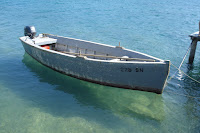MALI
STON AND STON
SWIMMING
Our first
full day on our cruise through the Dalmatian Islands started with a final swing
past Dubrovnik to admire this beautiful city from the sea before sailing through
the Elaphiti Island archipelago. Dubrovnik looked strong in the brilliant
morning light. The white umbrellas of the Buza Bar were the only bit of whimsey
that stood apart from this vast wall. We lingered briefly in the waters between
the main port of Dubrovnik and Lokrum Island before turning for a swim somewhere
in the Elaphiti Islands.
SWIMMING
Each day
we are to stop somewhere to swim in the warm blue waters of the Adriatic. When
the captain reaches his desired area, which is shared by all the other small
ships, he does a 180-degree turn to have the stern and diving platform face the
shore some 50 feet away. Then a launch pulls a rope to shore to keep the
Infinity from drifting and the anchor is dropped. The visibility of the water
is incredibly clear and I feel especially buoyant in the water salty water. The
first couple of days we have been blessed with an azure sky and the colors of
the water are a myriad of blues and turquoise. They have floats and masks and a
kayak. The water is calm and warm and one day I swam about the Infinity leisurely
admiring her lines. The blue blue blue water will be tough to leave once we’re
home. There’s nothing like this at home.
The first
day of swimming we moored near a terraced cliff in the Elaphiti Islands where
olive trees caught the salt air and sun. Tranquil, lovely, it was everything
one could dream for on a trip. The tumult of the Dubrovnik hordes was so very far
away.
OYSTERS
We had
lunch on board while the Infinity made its way to Slano, a small fishing
village. Unforgettable Croatia arranged a bus for us to Mali Ston. There we
boarded a launch to a small island to sample the local oyster. Mali Ston is at
the very base of the Plejesac Peninsula and the salty sea water mixes with the mineral
heavy water from the Neretva River to bring in a unique blend of nutrients. All
of which makes the Mali Ston oyster, a European flat oyster, award winning.
There
were several roughly hewn picnic tables with a couple bottles of Grappa and a
carafe of white wine. The pleasant and thankful hosts served us oysters, three
each, and then a massive cauldron of mussels and loaves of bread to sop up the garlicy
sauce. Our group was chatty with the Grappa but grew silent as we dug into all
the food.
As we
waited for the launch, we were given a short lecture about how the Mali Ston
oysters are farmed. They catch the oyster seeds in nets and the seedlings
attached themselves to this new home. The oysters are allowed to grow a bit more
before they are glued together two by two on another net where they age to
maturity. This takes 3 years. All along the bay the placement of these nets,
where oysters grow, are marked by barrels floating on the surface.
It was an
interesting and informative speech. To demonstrate the timeline of the aging,
the young man pulled up a seedling net and then one nearing maturity. We all
applauded him afterwards and he smiled widely, a genuinely warm smile. There
was no jaded approach to tourism that other places that cater to visitors have reached.
He was proud of his job and happy we were here. This has been the greatest joy
on this trip so far, to see this true sort of happiness. Oh well, the Grappa
was pretty good too!
STON
Salt is
harvested from the sea in Ston to this day. It was once so lucrative it was
called “white gold”. It made Dubrovnik rich and to protect their investments in
the evaporating salt ponds in Ston a great long wall was constructed above the
town. The wall stretches from Mali Ston to Ston, a few kilometers down the road.
It stretches across this entire section of the hilly Peljesac Peninsula and
some guidebooks say it’s the second longest wall ever built by man; the first being
the great wall of China. With our technology now there are more efficient ways
to harvest salt, but the salt farm of Ston still works its magic every summer.
We bought a bag of salt as a souvenir for 10 Kuna.
It is still
possible to climb much of the very steep wall, so after a quick lecture about the
way salt is still harvested from sea water those hardy enough to tackle the
stairs, followed the guide up the narrow stretch to a guard tower. Below us the
salt ponds stretched out towards the sea and above us the menacing wall stretched
over the crest of the hill. Spectacular views in either direction.
Thanks to
Unforgettable Croatia in making such day trips possible.
Thanks to
you for reading.
Love conquers
all, conquering a wall though requires strong lungs.
Janet and
greg






































No comments:
Post a Comment